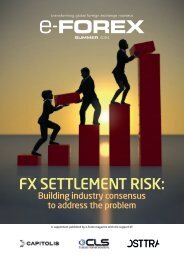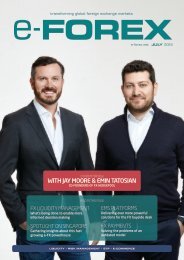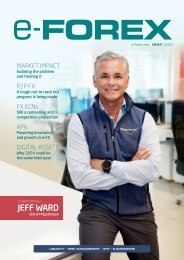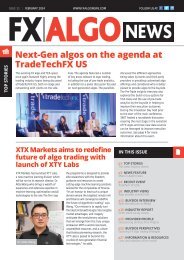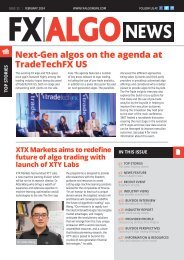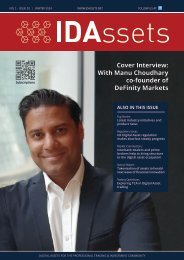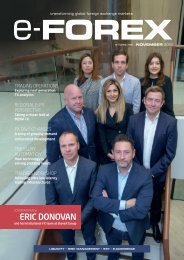You also want an ePaper? Increase the reach of your titles
YUMPU automatically turns print PDFs into web optimized ePapers that Google loves.
Next generation FX analytics: Bringing transparency and more to the FX execution process<br />
TRADING OPERATIONS<br />
“The historical approach of simply adding LPs via an EMS is<br />
no longer adequate because each LP and their effect on the<br />
pool needs to be understood.”<br />
benchmark from outside the system. It<br />
is from this information that the trader<br />
can create an execution methodology<br />
for each trade.”<br />
FairXchange’s Hopkins acknowledges<br />
the importance of independent data<br />
sources but stresses that analysis is<br />
just as critical. “It is important to<br />
differentiate between independent<br />
analysis and independent data,” he<br />
says. “Independent data analytics firms<br />
like FairXchange provide objective,<br />
neutral analysis of trading firms’ data.<br />
This gives firms valuable insights into<br />
their trading business that they might<br />
otherwise miss, and it also removes<br />
the perception of “marking your<br />
homework”. Indeed certain types of<br />
analysis only make sense when based<br />
on a particular firm’s data – their<br />
unique liquidity, for example,” he<br />
states.<br />
Paul Lambert<br />
When does incorporating a benchmark<br />
or ruler (as Lambert explained)<br />
hold water? “There are times when<br />
it is helpful to combine this with<br />
independent data sources,” Hopkins<br />
responds. “Particularly when the<br />
analysis is intended for third parties,<br />
such as clients, counterparties, or<br />
regulators. This gives a useful degree<br />
of standardisation, and can remove<br />
the potential for a given firm’s trading<br />
activity to leave a signature on the<br />
reference data against which trades are<br />
measured. It is also helpful for creating<br />
a level playing field, using objective<br />
data that counterparties can agree<br />
on.”<br />
COMBINING DATA WITH<br />
ANALYTICS TOOLS FOR MORE<br />
TRANSPARENCY<br />
“Data alone is quite useless without<br />
analytics,” Bloomberg’s Shevelenko<br />
says, “as analytics are a vehicle that<br />
make sense of your data and uncover<br />
meaningful conclusions. Therefore, data<br />
and analytics go hand in hand helping<br />
to constantly reshape the execution<br />
process, making it clearer and more<br />
transparent.”<br />
Hopkins believes data standardisation<br />
is a critical first step firms must invest<br />
time into. “Standardise the data into a<br />
format that permits firms to compare<br />
across different venues, trading<br />
platforms, and counterparties,” he<br />
says. “The analytics then need to be<br />
powerful enough to allow firms to<br />
quickly identify areas of interest, in real<br />
time if possible. This now extends to<br />
using AI to detect anomalies or issues<br />
that require attention.”<br />
He also points out that these analytics<br />
must be accessible to as broad a<br />
constituency of users as possible.<br />
“Data and data analysis are now part<br />
of everyone’s daily working life, it is no<br />
longer the province of a small number<br />
of highly qualified specialists,” he notes.<br />
Lambert counters that firms must<br />
look earlier in the cycle and focus<br />
on sourcing enough data. “Almost<br />
no buyside users can consume and<br />
analyse their available liquidity,”<br />
he says. “They are shooting in the<br />
dark without the data to understand<br />
their feeds and act accordingly. Most<br />
analysis available today is based on<br />
‘dead’ data, which offers little in terms<br />
of live execution problems.”<br />
He explains that using such data with<br />
algos doesn’t make sense. “The use of<br />
a historic database of algo executions<br />
to guess which algo to use now is like<br />
driving from A to B using last week’s<br />
traffic conditions when roadworks<br />
may have moved, and the weather<br />
may have changed. This challenge is<br />
what led New Change to build its<br />
Data Processing as a Service (DPaaS)<br />
offering. NCFX, under an ordinary<br />
platform agreement, can take feeds<br />
from banks and process them to<br />
produce live analytics for its clients.<br />
Clients can create their live midrate,<br />
see how a trade or algo execution<br />
with a bank affects the prices at every<br />
other institution, and triangulate their<br />
midrate with the independent midrate<br />
from NCFX and their own micro-price.”<br />
Lambert adds that while these feeds<br />
are built on live data, clients can store<br />
James Knoop<br />
“Being able to highlight areas where LPs are struggling<br />
against their peers or being deliberately toxic with their flow<br />
can lead to a closer collaboration between Bank and LP.”<br />
24 NOVEMBER 20<strong>23</strong> e-FOREX




